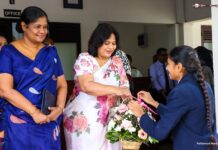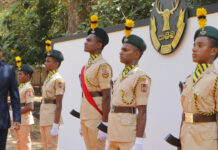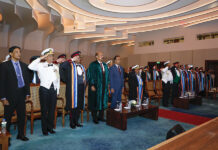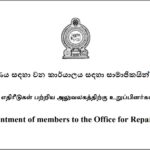Most accounts of education reform in British Ceylon focus on officials and administrators, rather than the people on the ground and the historical forces they had to contend with. Very little effort, indeed next to no effort, is made to situate reforms in a broader historical context. Works like Ranjit Ruberu’s Education in Colonial Ceylon (1962) and the Education and Cultural Affairs Ministry’s Education in Ceylon: A Centenary Volume (1969) do explore these areas, but these remain more the exception than the norm.
Whether scholars have gone beyond a colonial-centric reading of education reforms in 19th century Ceylon is of course debatable. But the need to go beyond such a frame of reference is evident enough. By paying attention to official accounts, we tend to view those reforms through the lens of colonial administrators, whose intentions may not have been as clear-cut as what their biographers would have us assume. On the other hand, we also fail to note the socio-cultural forces that shaped these reforms, including nationalist agitation, religious revival, and progressive forces within the administration itself.
The truth is that, like the society in which they came to be enforced, these reforms were riddled with ambiguities and contradictions. Hence, while colonial officials could dismiss vernacular education at the beginning of the 19th century, events like the 1848 Rebellion resulted in their successors viewing it less unfavourably.
At the same time, the administration distinguished between elementary and secondary education, limiting vernacular schooling to the former. The government did endeavour to expand facilities, but these conformed to the imperatives of confining superior education to a Westernised bourgeoisie. As Swarna Jayaweera has observed, “British policy consistently stressed quality rather than quantity in secondary education”.
Perhaps more than anything else, colonial reforms bequeathed a set of elite secondary schools to the country. The Donoughmore Commission noted this when it stated that the island was fortunate “in possessing a remarkable number” of such institutions.
These schools were run by the State, Christian denominational bodies, and other private interests. Many of them had been set up between 1835 and 1860, while schools founded by Buddhist, Hindu, and Muslim revivalists were set up in the latter part of the century. It was only in the Donoughmore period (1931-1947), when Ministers exercised more powers over their areas of specialisation and a radical Left entered the legislature, that facilities for which these institutions had gained a reputation were extended to the poorer masses.
It is from this standpoint that we need to assess the contribution of cultural and religious revivalists, progressive educationists, and historical forces to the education and curriculum reforms of late 19th British Ceylon. As the evidence makes it clear, these figures and forces played a part in reforming the face of education in colonial society, even if they did not bring about, much less promote, radical change within that society.
Preoccupied with the issue of the country’s finances, the Colebrooke-Cameron Commission recommended the establishment of a public school in Colombo, the reform of government schools, and the setting up of a Commission to administer education reforms. Established in 1834, the latter body collapsed seven years later due to various disagreements and clashes. It was followed by another Commission in 1841, which in turn gave way to a more successful institution, the Department of Public Instruction, 28 years later.
By this point in time, the colonial administration in Ceylon was being guided by two contrasting ideological impulses: utilitarianism and orientalism. On the one hand, colonial administrators gave priority to reforms that were practicable and in line with the objective of creating a class of Westernised elites. On the other, not a few of them found themselves drawn to the history of the country they were governing. These developments blended in with the tenor of education reforms and the Buddhist revival of the late 19th century. Their effects were to be felt more fully in the early part of the 20th century.
Probably the most crucial development at this time was the excavation of Anuradhapura. Coming in after centuries of neglect, the restoration of the former capital of the country left a deep impression on people, evoking memories of a lost civilisation and a lost grandeur. It awakened no less than a desire to reclaim a national heritage.
Fittingly, the publication of an Archaeological Commission of Inquiry in 1870 fed into a clamour to know more about the country’s past. Ceylon history, as it came to be called, soon preoccupied officials and elites, leading to the formation of groups like the Ceylon Reform League and provoking much debate among educationists.
These debates centred on a rather pressing problem. Since their establishment, secondary schools had exuded a literary bias, with curricula which placed emphasis on the classics at the cost of other subjects. Long noted as a weakness by officials attached to the Department of Public Instruction, there was very little done to change the situation.
The teaching of history, in particular, limited the child to Europe and India. At the Colombo Academy in the period under discussion, for instance, the two textbooks in use were John Murray’s Guide to India and John Marshman’s Brief Survey of Ancient History. The situation remained much the same elsewhere, with the exception of schools set up by the Buddhist Theosophical Society (BTS), where the revivalist objectives of the organisation mingled with a personal interest among foreign teachers and principals in local culture.
Two developments conspired to extend the teaching of these subjects to the island’s elite schools. Firstly, the Governors in charge at this point, in particular William Gregory, took an interest in studying the country’s past and setting up institutions for that purpose. Indeed, the likes of Gregory did not just direct funds to digging up ancient sites. They also financed the establishment of institutions like the Colombo Museum despite the misgivings of their more fiscally conservative colleagues. Under Gregory, moreover, science and art education was prioritised, though progress remained frustratingly slow.
Secondly, while Buddhist schools saw their share of teachers dedicated to the study of local history, at the turn of the century other schools also began employing such figures. The most prominent among them was W. G. Fraser, Principal of Trinity College for 20 years. Described as ‘the finest colonial headmaster of his day’, Fraser oversaw the teaching of Sinhala at Trinity and abandoned subjects imported from England.
Less well heard of than Fraser, but no less significant, was Charles Hartley. A classics and language master who had taught at a number of English public schools, Hartley served as Principal of the Colombo Academy, now renamed as Royal College, for 16 years. During his tenure he oversaw several reforms, including starting Sinhala and Tamil classes on Saturday mornings at ‘a fee of Rs. 2 per month’. Anne Blackburn notes that the school employed the brother of Hikkaduwe Sri Sumangala Thera as its first Sinhala teacher.
Hartley’s experiments became successful, and in 1908 ‘vernacular teaching was instituted in the time table of the lower forms’. Despite his classical training, he also took an interest in science education, commencing physics classes for Technical College students in 1907. That same year, he introduced Ceylon History ‘to the three upper forms’.
Such reforms continued to influence students even after Hartley’s term ended. In 1913 at the College, for instance, two prizes were offered for Ceylon History, pointing to a growing enthusiasm for the subject. Whereas oriental studies had been neglected in the early 19th century, in the early 20th century such subjects were being taught with much interest. More pertinently, towards the end of the 1920s the results of the Cambridge Examination began to record impressive improvements in history.
Noting these achievements, in 1930 a group of students and teachers conferred with each other and presented a proposal to the principal that led to the establishment of a Historical Association. For its inaugural meeting the Association invited G. C. Mendis to speak on ‘The study of history with special reference to Ceylon’, underscoring the interest in local history that had led to the founding of the society. Predictably, other public schools followed suit: S. Thomas’ College, for instance, formed such an association in March 1936.
These years and decades saw the publication of a number of history books. They included Paul E. Pieris’s Ceylon and the Portuguese (1913) and The Kingdom of Jaffnapatam (1920), H. W. Codrington’s A Short History of Ceylon (1929), L. E. Blaze’s History of Ceylon (1933), and G. C. Mendis’s The Early History of Ceylon (1940). Needless to say, they had a profound influence on the local curriculum, even at the elite secondary schools.
To say that is not to overrate these works. For the most, the early historians favoured a chronology that divided the past into a series of dynastic periods. It was much later, in the 1960s, that a new generation of historians departed from such frameworks and delved into the material base of society. In its own way, however, it is a testament to the influence of the early historians that our schools still adopt their chronology, with the syllabus focusing on ruling dynasties and clans. Whatever the limitations of such an approach are, there’s no denying that it has penetrated the classroom today, as it did in their time.
These developments were a product of the political, cultural, and social forces that came together in colonial society in the late 19th century. While the work of colonial officials and commissioners, who had their own peculiar motives in the field of education reform, have been noted and can’t be denied, the work of other individuals, including educationists and revivalists, is more significant than what they are given credit for.
What needs to be noted in conclusion is that the reforms overseen by these individuals reflected the ideological impulses of British colonialism. So long as they did not contradict the broader aims of the colonial project, these reforms by and large gained official support, begrudgingly though it was often given. This is not as astounding as it may seem: not even in the 1930s, on the eve of the Donoughmore Reforms, did the most ardent revivalist imagine a Ceylon falling outside the British orbit. It is this, essentially, that guided education reforms, within the framework, and the limits, of a plantation colony in Asia.












